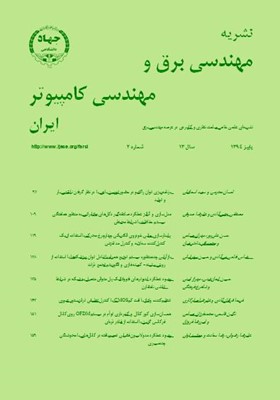بازآرایی چندمنظوره سیستم توزیع همراه با تبادل توان ریزشبکهها با استفاده از روش بیشینه- کمینه فازی و الگوریتم تجمع ذرات
محورهای موضوعی : مهندسی برق و کامپیوترعباس فتاحی میآبادی 1 , حسین سهرابیانی 2
1 - دانشگاه صنعتی همدان
2 - مؤسسه آموزش عالی مازیار
کلید واژه: بازآرایی ریزشبکه سیستم توزیع الگوریتم تجمع ذرات,
چکیده مقاله :
مجموعههایی از تولیدات کوچک و ذخیرهکنندههای انرژی در سیستمهای توزیع ولتاژ پایین یا متوسط در کنار مصرفکنندگان، نوع جدیدی از سیستم قدرت به نام ریزشبکه را شکل میدهد. طراحی اجزای ریزشبکه باید به نحوی باشد که هم به صورت متصل به شبکه و هم در حالت مجزا از شبکه، کارکردی ایمن و اقتصادی داشته و با شبکه بالادست خود به تبادل انرژی الکتریکی بپردازد. بدین ترتیب، حضور ریزشبکهها میتواند در مسایل مختلف برنامهریزی و بهرهبرداری از سیستمهای توزیع اثرگذار باشد. بازآرایی شبکههای توزیع در حضور ریزشبکهها یکی از موضوعات مورد توجه در این زمینه است. در مطالعات انجامشده، ریزشبکهها معمولاً به صورت تولیدات پراکنده در شبکه توزیع در نظر گرفته میشوند. در این مقاله، ریزشبکه به عنوان تبادلکننده انرژی با سیستم توزیع مدلسازی شده و تأثیر آن در بازآرایی شبکه توزیع بررسی میشود. برای این منظور، بازآرایی شبکه توزیع با استفاده از روش بیشینه- کمینه فازی در قالب یک مسئله بهینهسازی چندمنظوره فرمولبندی میشود که در آن کاهش تلفات و عدم تعادل بار در بین فیدرهای شبکه به عنوان اهداف مسئله و پروفیل ولتاژ، گرفتگی خطوط، شعاعیبودن و پخش توان به عنوان قیود مسئله مطرح میگردد. الگوریتم تجمع ذرات جهت حل مسئله بهینهسازی استفاده شده و نتایج حاصل از بازآرایی روی دو شبکه نمونه 33 و 70شینه IEEE ارائه میشود. نتایج نشان میدهد که تبدیل شبکههای توزیع از حالت سنتی به سیستمهای مدرن با حضور ریزشبکهها و تبادل توان آنها با شبکه، موجب افزایش قابلیت اعتماد شده و مقرون به صرفهتر خواهد بود.
A group of small generators and energy storages in the low or medium voltage distribution systems beside of consumers emerge to a new power system called micro grid. Micro grids are designed to have secure and economic operation isolated and connected to the network and exchange electrical energy with distribution system. Hence, they may impact on planning and scheduling of distribution systems. In this case, network reconfiguration is a considerable issue after presenting of micro grids to the system. In the previous studies regarding to this issue, micro grid is considered as a distributed generation which should only produce electricity to the network. In this paper, micro grid is modeled as a power exchanger in the distribution network to study the effect of it on the network reconfiguration. For this purpose, reconfiguration is formulated as a multi objective optimization problem using max-min fuzzy method. In this problem, power loss reduction and load balancing among feeders are two independent objectives and voltage profile, lines congestion, radial network structure and load flow are equality and inequality constraints. Particle swarm algorithm is applied to solve the optimization problem and the reconfiguration over two 33 and 70 buses IEEE test network is shown. Results demonstrate that replacing traditional distribution systems by modern active networks and exchanging power with micro grids can lead to increase the reliability of system and more economic operation.
[1] H. Karimi, H. Nikkhajoei, and R. Iravani, "Control of an electronically-coupled distributed resource unit subsequent to an islanding event," IEEE Trans. Power Del., vol. 23, no. 1, pp. 493-501, Jan. 2008.
[2] A. Singh and B. S. Surjan, "Microgrids: a review," Int. J. of Research in Engineering & Technology, vol. 3, no. 2, pp. 185-198, Feb. 2014.
[3] S. Civanlar, J. J. Grainger, H. Yin, and S. S. H. Lee, "Distribution feeder reconfiguration for loss reduction," IEEE Trans. on Power Delivery, vol. 3, no. 3, pp. 1217-1223, Jul. 1988.
[4] D. Shirmohammadi and H. W. Hong, "Reconfiguration of electric distribution networks for resistive line loss reduction," IEEE Trans. on Power System, vol. 4, no. 1, pp. 1492-1498, Apr. 1989.
[5] A. Merlin and H. Back, "Search for a minimal-loss operating spanning tree configuration in an urban power distribution system," in Proc. 5th Power System Computation Conf., pp. 1-18, Cambridge, UK, 1975.
[6] W. M. Lin, F. S. Cheng, and M. T. Tsay, "Distribution feeder reconfiguration with refined genetic algorithm," IEE Proceedings Generation, Transmission and Distribution, vol. 147, no. 6, pp. 349-354, Nov. 2000.
[7] T. Niknam, "A new hybrid algorithm for multiobjective distribution feeder reconfiguration," Energy Conversion and Management, vol. 50, no. 8, pp. 2074-2082, Aug. 2009.
[8] K. Prasad and R. Ranjan, "Optimal reconfiguration of radial distribution system using a fuzzy mutated genetic algorithm," IEEE Trans. on Power Delivery, vol. 20, no. 2, pp. 1211-1213, Apr. 2005.
[9] D. Das, "A fuzzy multiobjective approach for network reconfiguration of distribution systems," IEEE Trans. on Power Delivery, vol. 21, no. 1, pp. 202-209, Jan. 2006.
[10] Y. Xiaodan and J. Hongjie, "Network reconfiguration for distribution system with micro-grids," in Proc. Int. Conf. on Sustainable Power Generation and Supply, SUPERGEN'09, 4 pp., 6-7 Apr. 2009.
[11] R. Syahputra, I. Robandi, and M. Ashari, "Reconfiguration of distribution network with DG using fuzzy multi-objective method," in Proc. Int. Conf. on Innovation, Management, and Technology Research, pp. 316-321, Malacca, Malaysia, 21-22 May 2012.
[12] G. W. Chang, S. Y. Chu, and H. L. Wang, "A simplified forward and backward sweep approach for distribution system load flow analysis," in Proc. IEEE Int. Conf. on Power Systems Technology, 5 pp., 22-26 Oct. 2006.
[13] J. H. Teng, "A direct approach for distribution system load flow solutions," IEEE Trans. on Power Delivery, vol. 18, no. 3, pp. 882-887, Jul. 2003.
[14] M. E. Baran and F. F. Wu, "Network reconfiguration in distribution systems for loss reduction and load balancing," IEEE Trans. Power Delivery, vol. 4, no. 2, pp. 1401-1407, Apr. 1989.


